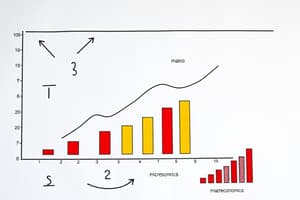Podcast
Questions and Answers
What does microeconomics primarily focus on?
What does microeconomics primarily focus on?
- Individual and business decision-making (correct)
- Government spending and taxation decisions
- The overall economy and national income
- Foreign exchange and trade between countries
Which market structure is characterized by a single firm dominating the market with a unique product?
Which market structure is characterized by a single firm dominating the market with a unique product?
- Perfect Competition
- Monopolistic Competition
- Monopoly (correct)
- Oligopoly
What is the opportunity cost of a decision?
What is the opportunity cost of a decision?
- The economic benefits gained from a particular investment
- The amount of money spent on supplies
- The total expenses incurred for a product
- The benefits received from the best alternative forgone (correct)
Which of the following best describes Keynesian economics?
Which of the following best describes Keynesian economics?
What is the Gross Domestic Product (GDP) a measure of?
What is the Gross Domestic Product (GDP) a measure of?
What characterizes an oligopoly market structure?
What characterizes an oligopoly market structure?
Which monetary policy tool is primarily used to influence the money supply?
Which monetary policy tool is primarily used to influence the money supply?
What is the primary goal of fiscal policy?
What is the primary goal of fiscal policy?
Flashcards are hidden until you start studying
Study Notes
Key Concepts in Economics
1. Definition of Economics
- Study of how individuals and societies allocate scarce resources.
- Focuses on production, distribution, and consumption of goods and services.
2. Microeconomics vs. Macroeconomics
- Microeconomics: Examines individual and business decision-making (e.g., supply and demand, pricing).
- Macroeconomics: Looks at the economy as a whole (e.g., national income, inflation, unemployment).
3. Basic Economic Principles
- Scarcity: Limited resources vs. unlimited wants.
- Opportunity Cost: The cost of forgoing the next best alternative when making a decision.
- Supply and Demand: Relationship between the quantity of a good available and the desire for that good.
4. Market Structures
- Perfect Competition: Many firms, identical products, free entry/exit.
- Monopolistic Competition: Many firms, differentiated products, some control over price.
- Oligopoly: Few firms, interdependent pricing, potential for collusion.
- Monopoly: One firm dominates, unique product, high barriers to entry.
5. Economic Indicators
- Gross Domestic Product (GDP): Total value of all goods and services produced in a country.
- Unemployment Rate: Percentage of the labor force that is unemployed.
- Inflation Rate: Rate at which the general level of prices for goods and services rises.
6. Fiscal and Monetary Policy
- Fiscal Policy: Government spending and taxation decisions to influence the economy.
- Monetary Policy: Central bank actions that manage the money supply and interest rates.
7. International Economics
- Trade: Importing and exporting goods and services between countries.
- Exchange Rates: Value of one currency for the purpose of conversion to another.
- Balance of Payments: Record of all economic transactions between residents of a country and the rest of the world.
8. Economic Theories
- Classical Economics: Free markets regulate themselves.
- Keynesian Economics: Active government intervention is necessary to manage economic cycles.
- Supply-Side Economics: Emphasizes boosting supply to encourage growth.
9. Behavioral Economics
- Studies how psychological factors affect economic decision-making.
- Challenges the notion of rational decision-making.
Conclusion
Economics is a broad field that encompasses various theories, indicators, and policies aimed at understanding and improving the allocation of resources within societies. Understanding these concepts lays the foundation for analyzing both individual and collective economic behavior.
Definition of Economics
- Economics analyzes how individuals and societies manage limited resources amidst infinite desires.
- It emphasizes the processes of production, distribution, and consumption of goods and services.
Microeconomics vs. Macroeconomics
- Microeconomics focuses on decision-making at the individual and business levels, considering concepts such as supply, demand, and pricing strategies.
- Macroeconomics examines broader economic factors, including national income, inflation levels, and overall unemployment rates.
Basic Economic Principles
- Scarcity highlights the imbalance between limited resources and unlimited wants.
- Opportunity cost is the value lost from opting for one choice over the next best alternative.
- Supply and demand describe how the availability of goods correlates with consumer desire.
Market Structures
- Perfect competition features numerous firms selling identical products with unrestricted market entry and exit.
- Monopolistic competition includes many sellers offering differentiated products, allowing some pricing power.
- Oligopoly is characterized by a few firms with interlinked pricing strategies and potential collaborations.
- Monopoly exists when a single firm dominates the market, providing a unique product with significant barriers to entry.
Economic Indicators
- Gross Domestic Product (GDP) measures a country's total production of goods and services.
- The unemployment rate indicates the portion of the labor force that is not currently employed.
- Inflation rate reflects how quickly the overall price level of goods and services is rising.
Fiscal and Monetary Policy
- Fiscal policy involves government decisions regarding spending and taxation to influence economic performance.
- Monetary policy refers to actions by central banks to control the money supply and set interest rates to stabilize the economy.
International Economics
- Trade encompasses the import and export activities related to goods and services among nations.
- Exchange rates determine the relative value between different currencies during conversions.
- Balance of payments tracks all economic transactions between a country’s residents and the rest of the world.
Economic Theories
- Classical economics advocates for self-regulating free markets.
- Keynesian economics argues for government intervention to stabilize economic fluctuations.
- Supply-side economics focuses on stimulating growth by enhancing supply capabilities.
Behavioral Economics
- Behavioral economics investigates how psychological influences affect economic decisions.
- It challenges traditional assumptions of rational decision-making in economic behaviors.
Conclusion
- Economics represents a multidisciplinary field that integrates theories and practices aimed at optimizing resource distribution in societies.
- Familiarity with these concepts is crucial for understanding economic behavior on both individual and societal levels.
Studying That Suits You
Use AI to generate personalized quizzes and flashcards to suit your learning preferences.




